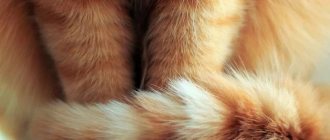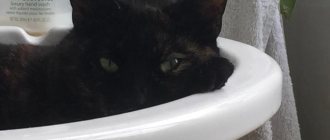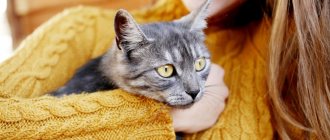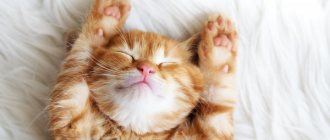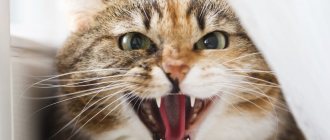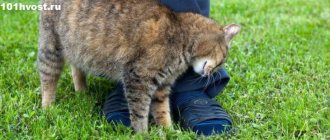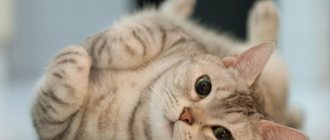A caring owner always tries to determine the well-being and mood of a pet by body movements, voice, and appearance. A cat's tail exhibits a wide range of emotions; after studying its movements, the owner can easily find a common language with an aloof, disobedient animal. Cats actively wag their tail for positive and negative reasons related to their emotional and physical state.
Why do cats have tails?
Flexible organ - the end part of the spine, starting from the sacral region, divided into 3 subsections:
- root zone – close to the sacrum, including 4-6 vertebrae (the initial ones are shortened, flattened, the rest are cylindrical);
- stem zone - the main, most flexible, mobile, including 10-15 cylindrical vertebrae;
- terminal zone - consists of small, thickened, shortened vertebrae (the last vertebra is a rudiment of a deformed shape).
The caudal section of the spinal column in a cat consists of 20-27 vertebrae (the different sizes are determined by the breed). The organ is flexible and mobile thanks to elastic ligaments and intervertebral discs. Motor activity is provided by 3 large tail muscles and several small ones.
Functions performed by the long caudal spine:
- helps the animal to balance, with incredible dexterity to stay on uncomfortable, inclined, narrow surfaces;
- provides spatial orientation;
- acts as a thermostat (the cat fans itself in hot weather, takes shelter in cold weather);
- allows the animal to communicate with relatives and the owner.
Voice is a secondary communication tool for cats. Animals transmit a significant part of information through body movements and wagging of the vertebral process. It is easy to find out about your pet’s mood and well-being by changes in the spatial position, amplitude and rhythm of organ movement.
Why do cats wag their tails?
The cat waves its tail differently, the movements reflect a certain emotion, positive or negative. The cat shakes its tail with a certain intensity, proportional to the strength of the emotions experienced.
Kittens often catch and bite their own tail, which acts as a toy and helps them acquire hunting skills.
Since a cat has an individual character and behavior, tail movements may not mean what is commonly believed. Therefore, it is recommended to determine cat emotions from your own experience, focusing on the information presented.
Positive reasons
There are many positive reasons why cats noticeably wag their tails:
- are in a playful mood and invite you to play;
- express love for the owner and household members (the vertically raised tip trembles);
- show interest, curiosity (slight twitching);
- they feel happiness, satisfaction, express complete calm (they move only the tip of their tail);
- express friendliness and trust (the caudal vertebrae are parallel to the floor);
- experience the excitement of the hunt, observe a potential victim - a mouse, a fly, a bow on a rope;
- are thoughtful (broad, relaxed movements);
- feel satisfied, want to communicate (the caudal process is lowered, relaxed);
- feel superiority and security, are confirmed in leadership (hold the organ like a “pipe”);
- thank the owner for his care and affection (the cat slowly and smoothly waves its tail).
Negative reasons
For both negative and positive reasons, a cat often wags its tail:
- dissatisfied, angry (swings sharply and actively in the horizontal direction);
- experiences aggression, irritation (lowered, nervously hits the floor);
- is in a stressful state, shocked (hitting the floor intensely, chaotically);
- got scared (squeezed);
- warns, preparing for a jump, attack (movements accelerate);
- very angry, ready for a furious attack on the enemy (the tail is directed upward, motionless, may twitch slightly, the fur is tousled);
- feels danger, is ready to defend itself (the caudal vertebrae are directed upward, arched);
- affected by skin parasites (the skin twitches, the cat constantly itches, gnaws, the character becomes restless);
- sexual desire, estrus is the physiological reason why a cat’s tail shakes convulsively (the pet bends its hind limbs, raises the shaking appendage of the spine).
In addition to the period of estrus, cats shake their tail, as if marking, when experiencing severe pain.
What does a cat's tail mean?
Think for a moment how many different movements a cat makes with its tail in just a few hours. It can be raised up, down, wobble from side to side, move slowly or quickly, wrap around your leg or any object in the house. What does all this mean? In addition to movement, the position of the hair growing on the tail is important.
Let's look at the main positions of a cat's tail and try to figure out what our pets are talking about:
The tail is set straight
- This is a signal that your cat is friendly or reserved. In the second case, we are talking about a reaction to a stranger, another animal or an atypical situation. A mother cat with her tail raised vertically calls on her kittens to follow her. Perhaps the raised tail helps visually impaired babies locate their mother. From the side of small kittens, a vertically raised tail means greetings and joyful emotions associated with the meeting. An adult cat raises its tail up when petted - this is a respectful greeting.
The tail is raised back at an angle
– shows interest, misunderstanding or desire to learn about something. This situation is typical when two animals meet. Both animals are confused, do not know what to expect from the stranger, but are “burning” with curiosity. It is worth understanding that a tail that is held at an angle is an “incomplete pose.” The cat should either raise its tail straight up, which will indicate friendliness, or take another position, indicating a readiness to defend itself or attack.
Tail up, swaying
- at the same time, the cat wags its tail like a dog, cutting through the air with a wide amplitude. In this case, the pet behaves with slight irony; perhaps he is upset and wants to be left alone. If, in response to your calmness, the cat moves away, still shaking its tail, the signal is deciphered correctly. If the message is ignored, the cat may get angry or demonstratively do other things.
The tail is raised vertically, shaking
– we are not talking about tremor, but about expressive, periodic trembling. This gesture does not foretell anything bad; it shows joy or a friendly greeting. Typically, such tremors can be noticed after returning home from work or waking up in the morning. In addition to trembling, you may observe your cat stretching intensely or tilting its tail toward its back. This behavior means that the pet is experiencing strong emotions; it is literally overwhelmed by joy and that pleasant feeling that you feel after separation from a loved one.
Tail raised, tailbone curled
– visually, the tail resembles a question mark – “?”. The position of the tail completely reflects the state - the cat is interested in something, but does not quite understand what to do, that is, it asks: “How does it feel about this?” If in this position the cat wags the tip of its tail, it is more interested than tense.
The tail is relaxed, but the tip is twitching
– indicates concentration and interest. This can be observed when your pet looks out the window or watches the fish in the aquarium. By twitching the tip of its tail, the cat instinctively lures a stupid bird or fish towards itself - this is a hunting skill.
The cat wags its tail strongly from side to side
- This is a sign of irritation. The pet whips itself on the sides with its tail, encouraging it before an attack; it shows the seriousness of its intentions. There are not many reasons for this behavior:
- Intense anger or agitation.
- Inviting another cat to play.
- Willingness to make a dash during the hunt.
Why do cats wag their tails?
In males and females, the terminal part of the spine performs a communicative function. The cat noticeably wags its tail - demonstrating a wide range of emotions: from anger to endless love.
Positive reasons
A cat generally wags its tail, expressing similar emotions as a cat. The only difference is the sexual behavior of different-sex animals.
If the cat begins to shake its tail appendage, indicating readiness for mating, then the cat vigorously shakes its tail, marking the territory. Females also leave marks, but less frequently.
The secretion for the marks is synthesized by glands near the anus. When a cat marks its favorite territory, it sets the boundaries of its management. Marks calm the cat, give confidence, and establish leadership.
Negative reasons
It’s easy to determine a cat’s negative mood by its tail. The reasons are generally similar, but it is necessary to remember sexual behavior.
Females are usually neutral towards their relatives, while the male behaves aggressively and territorially. The territory designated for feeding and mating is protected from encroachment by rivals. If a cat encounters a competitor, it demonstrates pugnacious behavior and changes its body position.
Cats don't start fighting right away. First, they take a threatening pose and freeze for several minutes. The angry cat furiously swings its tail from side to side, lashing the ground and its own sides. It rears and fluffs the fur so much that it seems twice as large, growls dully, and hisses. The described behavior means that the male is ready to attack; it is better for the enemy to get out of the way. Sometimes a cat manages to scare the enemy, force him to surrender, and leave without a fight.
Other emotions
The tail will also tell you about other features of the cat’s mood. Let's look at what else his movements indicate.
A thoughtful wagging of the tip of the tail - something attracted the cat's attention. She listens, sniffs, looking for an object that interests her, and moves her tail to the beat of her “reflections.”
At such moments it becomes like a question mark. Calm wiggles while playing with the owner demonstrate her good disposition and pleasure from having fun together. However, during gameplay the cat may begin to cross the boundaries of permitted behavior. This will be noticeable by the accelerating movements of the tail, which may be followed by painful bites and scratches on the person. Cats wag their tails vertically when they are either sexually aroused or want to play. When a cat, instead of waving its tail, taps it on the floor with small nervous movements, this means that it is not just nervous, but is experiencing stress. Also, tapping often indicates that your pet is in pain. Having noticed that the cat began to wag its tail in this way, the owner needs to be alert and provide assistance to the animal.
Some owners notice that the cat constantly wags its tail when dozing. Smooth, gradually subsiding movements indicate that the animal is comfortable, it feels safe and is gradually going to sleep. Having fallen soundly asleep, cats sometimes also begin to twitch their tail. Scientists believe that they dream and react to them in a similar way. Having noticed such body movements in a sleeping pet, the owner need not worry - his pet is simply “chasing” another mouse in his sleep.
What other reasons are there?
The owner is obliged to carefully monitor the pet in order to determine its mood and promptly identify developing pathologies. Cats are stingy in showing emotions; it is not always possible to determine that a pet is sick by appearance. The only accurate way to understand that an animal needs help is to observe the movements of the caudal spine.
The tip of the tail twitches
The pet wags its tip - either it is in a playful mood, or it is concerned about the lack of attention to its own person. Usually, a cat who wants to play, having noticed a curious object, examines it with interest and at the same time twists the tip. The trembling tip of a pet intensely staring out the window means that you have an unbearable desire, but it is impossible, to attack the birds in the yard.
Tail and back twitching
When a cat is healthy, its back twitches closer to its tail when it is nervous, irritated, or dissatisfied. The pet needs privacy and prepares to respond to squeezing with aggression.
An animal may jerk its back due to certain diseases:
- rabies - intense back spasms;
- parasitic infection - marked by twitching skin on the back half of the body;
- neurosis is a common reason why a cat’s tail twitches chaotically;
- vertebral injury – the pet presses the tail vertebrae;
- cancer - the cat begins to wave chaotically and constantly.
The tail is shaking
A slight trembling is a sign that the kitten has discovered an interesting object and is showing curiosity.
Quickly, with a low amplitude, the raised caudal process begins to tremble during the period of sexual heat: the pet becomes acquainted with an individual of the opposite sex. Similarly, a cat twitches its tail, expecting its owner to give it its favorite treat.
Tail held high
A vertically raised shoot held straight is a sign of friendliness. Cats usually perform an action that signifies joy and a desire to caress when they meet their beloved owner on the threshold. Sometimes, using the described method, the cat begs for a treat, demands to be stroked, at the same time purrs, and rubs against its shin.
Fluffy fur from the base to the tip of the raised spine means that the cat is scared and trying to cope with fear. The pet rears up - scared, but tries to scare the enemy in response.
Such defensive behavior is shaped by evolution in mammals. Homo sapiens has no fur, so the body is covered with goosebumps.
The cat, in addition to the above changes, arched its back and rounded its eyelids, which means extreme anger. Perhaps he noticed the offender, an angry dog.
Tail down
The explanation for the drooping tail varies:
- fear, dissatisfaction, desire to remain in peace and quiet;
- alertness, mistrust, confusion (lowered and extended position);
- sharp fear (tail fur fluffed up, limbs tucked in);
- diseases of internal organs (simultaneous symptom – apathy);
- internal pain (the cat either cannot wag its tail or nervously waves it).
The pet must be taken to a veterinary clinic if suspicious symptoms appear, in addition to sagging of the spinal process.
Why do cats purr when petted?
Cats purr when petted for the obvious reason - they want attention.
From early childhood, the kitten does certain things and watches the owner's reaction. If, from the kitten’s point of view, the owner’s reaction is incorrect, he reinforces his messages with his voice (meowing or purring). The pet monitors reactions and remembers them, thus inventing a special language for communicating with the owner. Incredibly, observations of cats have revealed that they purr and meow louder and are difficult for people to hear. This is another fact proving that purring and meowing is a special language that a cat masters with experience.
What emotions does the purring of a cat evoke in you? Most likely you are touched, talk to the cat, stroke it or call it to you. The pet learns that if it purrs, it will receive a portion of additional attention. If you frequently give your cat treats by holding her, purring may indicate a desire for a treat. In any case, most cats use purring at humans to achieve something.
This range is very close to the cry of a baby (to which a person reacts instinctively), so cats use it to manipulate the owner.
Why you shouldn't pull your pet's tail
The cat should not be pulled by the thin tail vertebrae. According to popular belief, the pet will begin to defecate in the wrong corners. In reality, these actions are cruel, physically unpleasant for the animal, cause discomfort, and often cause injury and illness.
A bully, grabbing a cat wagging its tail, can injure the vertebrae, requiring surgical assistance or amputation.
Often hooligan actions lead to paralysis of the hind limbs and urinary incontinence in the pet.
Cats are vengeful, tugging and squeezing - which means humiliation of dignity - does not forgive, they begin to take revenge.
How to determine your mood by your tail
During the day, your pet experiences a wide range of emotions. It’s easy to determine a cat’s mood by looking at its tail. To understand body language, it is enough to carefully observe the animal:
- The cat lifts the tip, bends it, and at the same time begins to purr - hinting at the desire to be left alone and alone. The mood is neutral, the animal is tired of attention.
- A cat in a sitting position peers at the owner, slowly wagging the end part of the appendage to the right and left - attracts attention.
- A process raised above the floor at an angle, meaning that the animal is thinking about its next actions, is alarming. It’s impossible to guess what an energetic cat will do: jump on the curtain, pee in his shoes.
- The pet bent down to the floor and pricked up its ears. The reason why a cat excitedly twitches its tail is an awakened hunting instinct. The gaze fell on the potential victim.
- The cat purrs sweetly, squints his eyelids, rolls over on his back when being stroked, smoothly waves his tail tip - a manifestation of calm, bliss, and the highest degree of trust.
- The cat is tired of petting - the purring stops, the tail beats become sharp, and the amplitude increases. The animal opens its eyelids and glances displeasedly at the stroking palm, hinting that it’s time to stop.
- The dozing cat twitched on the lounger - she felt discomfort and sensed danger. Perhaps loud noises in the home, outside the window, were disturbing.
- The cat sat down with his back to his owner, exposing and raising his precious organ - not a sign of contempt, but a manifestation of complete trust.
- The cat leans against the owner's shin, wraps its tail vertebrae - trying to beg for a treat, affection.
- The pet, slightly bending the raised tip, approaches the owner, slightly bites the shin - trying to attract attention, remind them of the need to feed and play.
The caudal spine is a way of balancing, coordinating movements and communicating. By observing how a cat's tail twitches and trembles, it is easy to determine its mood and physical condition. Cat body movements are more eloquent than meowing, helping the owner to establish contact with the animal.
How else can a cat “talk”?
The tail is not the only way a cat can show its attitude. Animals have quite a lot of visual aids: ears, paws, and the whole body. Quite often they convey information using sound signals.
Tailless cat breeds
The human-cat dictionary can be supplemented with the following sections.
Communication using the body
Cat conversations can involve the whole body. With the help of movements, the animal is able to convey all important information and clarify details “left unsaid” by the tail.
Gesture Image Designation Ears raised up and tense
“I’m interested”, “I’m listening to you” Mustaches point forward
“I am completely happy, calm and content.” Mustache points back
“There is danger somewhere nearby, but I’m on alert” Head down
“I recognize your superiority”, “I’m bored” Fingering with paws
“I love you”, “I want to please you” Rubbing on feet
“You are only mine”, “Stroke me” Somersault, belly up pose
“I trust you completely”, “I love you” Trying to touch a person’s face with a paw
“I need your attention”, “Stroke me” Stand on half-bent legs
“I feel danger, but I want to avoid a fight”; “Let’s resolve everything peacefully or I can’t vouch for myself.” Arched back
"I will fight"
Communication using glances
Eyes also play a huge role in dialogue. By studying the cat's language of views, you can not only learn to understand your pet, but also respond to him in such a way that he understands.
Do you want to tell your pet that you love him? Then squint a little and look closely into his eyes, and then slowly blink a few times
- bulging eyes, unblinking gaze - “I am the strongest here, go away”, “Fear me”;
- squinting, blinking - “I like you”, “I feel calm and comfortable.”
What does the position of a cat's ears indicate?
Communication using sounds
Scientists estimate that cats can make about 30 different sounds. Each has its own meaning. Sometimes it is difficult for a person to distinguish one from the other. The owner’s ear may not be able to detect the change in timbre and volume. But there is a rule that will help determine the mood of the pet giving the sign. The lower his “meow” sounds, the more negative emotions he experiences.
The basic sounds that cats make can be translated into human language as follows:
the usual even meow - “I need attention”, “Show me how you love me”; loud insistent meowing - “Give me something to eat”, “Pour me some water”, “Open the door for me”; deep guttural growl - “I’m very angry”, “Everyone disperse!”; hissing - “I’m scared, but I will defend myself to the last”, “Now I’ll give you a beating”; purring - “I feel very good”, “Keep doing what you are doing”; squeal - “It hurts!”
How to determine a cat's mood
